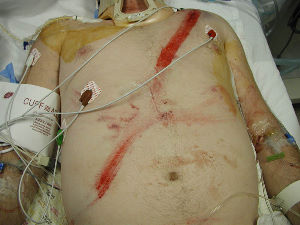Blunt Abdominal Trauma Is Harder To Diagnose
Published (updated: ).

Abdominal trauma caused by blunt force is a common presentation in the emergency room seen in adults and children. The chief cause of blunt abdominal trauma in the United States is motor vehicle accidents. Other rare causes include falls from heights, bicycle injuries, injuries sustained during sporting activities, and industrial accidents. In children, the most common causes are due to motor vehicle injuries and bicycle accidents.
Epidemiology
Blunt trauma to the abdomen can occur in people of all ages and is associated with a high morbidity. Each year thousands of patients with blunt abdominal injury are seen in emergency departments, and this substantially increases the cost of healthcare. Blunt abdominal trauma can cause damage to the internal organs, resulting in internal bleeding, cause contusions, or injuries to the bowel, spleen, liver, and intestines. Patients can also present with extra-abdominal injuries such as extremity injuries.
History and Physical
Because the presentation is often not straightforward, the diagnosis can be difficult and often time-consuming. Besides pain, the patient may present with bleeding per rectum, unstable vital signs, and the presence of peritonitis. The physical exam may reveal marks from a lap belt, ecchymosis, abdominal distention, absent bowel sounds and tenderness to palpation. If peritonitis is present, abdominal rigidity, guarding and rebound tenderness may be present. The mechanism of injury, motor vehicle speed, associated deaths at the scene, uses of alcohol or other substance of abuse must be taken into account so as not to miss an injury.
Evaluation
The evaluation of any trauma patient begins with evaluating the airway, accessing the breathing, and managing the circulation. The diagnosis of intra-abdominal injury following blunt trauma depends primarily on the hemodynamic status of the patient. If the patient is hemodynamically stable, CT scan is the ideal test to look for solid organ injury in the abdomen and pelvis. For unstable patients, one may perform an ultrasound (Extended Focused Assessment with Sonography for Trauma (EFAST)) or diagnostic peritoneal lavage, both of which are associated with a high rate of false negatives and false positives.
All indications for trauma ultrasound include blunt or penetrating trauma to the torso where there is a suspicion of intraperitoneal hemorrhage, pericardial tamponade, and hemothorax.
Treatment / Management
Treatment of patients with blunt abdominal injury requires the routine ABCs (Airway, Breathing, and Circulation). Once the airway is protected, it is mandatory to protect the cervical spine. After the primary survey is complete, patients who are hypotensive require aggressive fluid resuscitation. If hemodynamic instability persists, blood should be typed and crossed, but in the meantime, immediate transfusion with O negative blood can be done (O+ for males and women past childbearing years). All patients with blunt abdominal trauma who have signs of peritonitis, frank bleeding, or worsening of clinical signs require an immediate laparotomy. Non-surgical treatment in patients with blunt abdominal injury depends on the clinical features, hemodynamic stability and results of the CT scan. Advances in angiography can now help control hemorrhage with the use of embolization therapy, which is more cost effective than laparotomy. In general, the prognosis of patients with blunt abdominal trauma is good.
Differential Diagnosis
- Domestic Violence
- Hemorrhagic Stroke
- Hypovolemic Shock
- Lower Genitourinary Trauma
- Penetrating Abdominal Trauma in Emergency Medicine
- Pregnancy Trauma
- Upper Genitourinary Trauma
Pearls and Other Issues
Mortality rates have substantially decreased in the last two decades as trauma centers have streamlined the approach to diagnosis and management. Mortality rates do vary from 2% to 10% and are most common in people with multiple organ injuries who present with shock and frank hemorrhage.
According to the Centers for Disease Control, traumatic injury is the leading cause of death in people younger than the age of 44. Many traumatic injuries can be prevented, beginning with awareness and education. Blunt abdominal trauma is in the top three categories of preventable injuries. These include older adults falls and preventable motor vehicle accidents in teens.
